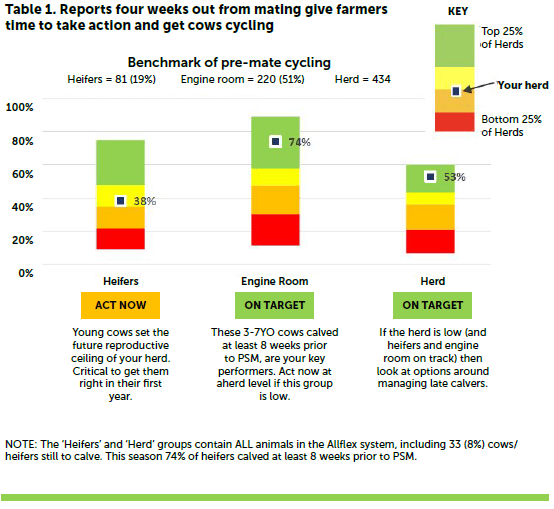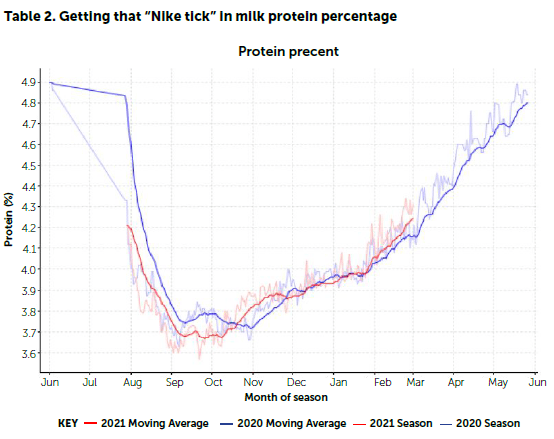Cow collar heat detection of whether they are on track or need to take action to improve in-calf rates. By Anne Lee.
Data from cow collars combined with other production and cow feeding data is providing new insights so that farmers can act before mating and boost their herds’ mating performance.
Waimate Veterinary Centre vet Ryan Luckman told farmers at Lincoln University Dairy Farm (LUDF) focus day in September there had been a high number of early adopters of collar technology in his district.
Interrogation of clients’ Allflex data, combining it with other known information such as milk protein percentage and energy balance information had shown striking correlations with conception rate records.
Pre-mating heat detection by the collars had enabled vets at the practice to develop reproduction reports for farmers that could be delivered four weeks before mating, giving farmers a heads up if they were on track or needed to take action to improve in-calf rates.
The reports, (Table 1), break out three groups of animals – heifers, the engine room and the herd, showing what percentage of each group had shown premating heats up to that four weeks before mating point.
The engine room cows are all three to seven-year-old cows that have calved at least eight weeks prior to planned start of mating.
Heifers are important because they set the future reproductive performance of the herd but the engine room cows set the current season’s ceiling.
The herd is the whole group – if the heifers and engine room cows’ are right on track but the whole herd report is low it shows there are too many late calving cows.
Data from herds using the Allflex collars within the practice is used to form the benchmark information in the reports.
To create the four, 25 percentile, benchmark groups – coloured green to red, they used clients’ data from the previous year, showing what the top 25% achieved right down to the bottom 25%.
The value of the reports is they come out four weeks before mating so there is still time to act, he says.
GET THEM CYCLING
“What we know is that by getting cows on to a rising plane of nutrition we can get more energy into them and they’re going to be more likely to cycle, more likely to have higher conception rates and more likely to hold (stay in-calf).”
Farmers can do that three ways:
- Either by increasing their energy inputs – by increasing feed offered, running heifers in a separate herd to reduce competition when grazing and/or targeting higher quality pasture.
- Decreasing energy output by once-a-day (OAD) milking for affected groups, OAD for late calvers until they have cycled or two weeks after they have been mated.
- Maximise their health, metri-check, optimise minerals, drench, monitor/reduce mastitis and lameness.
Ryan says they consistently see significant improvements with six-weekin-calf rate when late calvers are put on OAD until they’ve cycled or until after they’ve been mated and big drops in empty rates.
“You really can salvage them and get them back into line – you just have to work out whether the sacrifice in milk for that extended period makes it worthwhile.”
TRACKING MILK PROTEIN AND PUSHING UP ENERGY INTAKES
Tracking protein is probably one of the biggest indicators and a very accessible way to monitor energy balance (Table 2).
“We want to see that “Nike tick” so the protein percentage comes back up.
“The herds we see that have that perfect tick, those are the ones hitting the 60% conception rates because they are really getting that rising plane of nutrition going into mating.”
To achieve that some farmers are moving a portion of their autumn supplement into the premating spring period and lifting total energy intake.
While that could help, managing pasture well in the first round and hitting target residuals to ensure top-quality pasture in the second round is key, he says.
“We have to go back to those key messages around grass quality and grass utilisation – it’s what we’re seeing with the collar data too.”
He had looked at weekly conception rates and then looked at rumination rates, milk protein percentage and production and says he got good at pinpointing when conception rates would drop.
It often correlated with a drop in milk production, protein percentages flattened off or dropped and rumination suddenly jumped. When he calculated the energy balance for the herd based on feed input and quality along with milk production, maintenance and walking demands it was clear the rumination, milk protein and production metrics together were also an indicator cows were going into negative energy balance right at the planned start of mating. On higher stocking rate farms, he said some farmers had got into the habit of carrying a higher average pasture cover as a buffer but the quality of the pasture was suffering and was showing up in rumination rates. That’s where care must be taken when using rumination data with other factors taken into consideration so you understand what is driving the numbers, he says.
“If rumination rates suddenly drop, for example, and you have 2000 litres extra in the vat, the herd may have gone onto high-quality pasture.
“If rumination drops and production drops you might have underfed them – or something else is at play.
“If rumination rates go up and your production goes down it’s likely that pasture quality has dropped and fibre levels in the grass have gone up.”
So rather than sticking doggedly to a target of 450 or 500 minutes (of rumination time) for example, have an understanding of what is going on in the system as a whole, he says.
Farms where conception rates go well for the first three weeks of mating but then drop over the three to six week period are likely to have done everything well with transition and have been leading up to mating with a rising plane of nutrition.
Then they hit the start of mating and get into peak milk production and cows dip into negative energy balance again.
“You drop them into a hole right at the planned start of mating. The oocytes (eggs) produced then, should be fertilised at weeks three to six but you see that classic dive in conception rate.”




